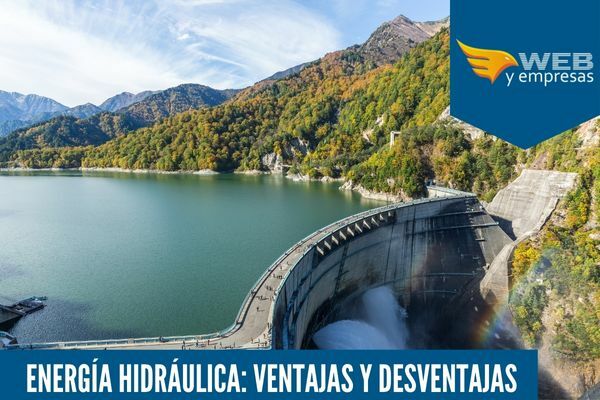The hydraulic energy It is one of the most common energy sources that exist. to produce electricity on a large scale, taking advantage of the force of the movement of water by subjecting it to a slope or waterfalls, which turn large turbines to produce energy.

Advertisements
Large-scale hydropower is produced by hydroelectric power plantsinstalled in large dams or reservoirs; however, since ancient times the force of water was already used to produce energy through water mills.
Although hydraulic energy is very effective for generating electrical energy, this, as well as its advantages, has great disadvantages, as can be seen in the following table:
Advertisements
| Advantages | Disadvantages |
| Clean and sustainable energy. | High initial investment. |
| Is a renewable energy. | It depends on the weather conditions. |
| It is cheaper to produce and maintain. | They alter the natural environment of the place. |
| The energy produced is more accessible to the population. | Inhibits the normal behavior of fish. |
| Generates water storage for agricultural irrigation. | It requires large areas of surface to store a large volume of water. |
| Enhances the landscape effect. | It generates population displacement. |
| It generates direct and indirect sources of employment. | It requires suitable geographical conditions. |
As can be seen in the table of advantages and disadvantages, hydropower, although it has points in favor, also has in against, that is why in this post we will detail what they consist of, but not before knowing what hydraulic energy is about and its functioning.
Advertisements
In this article you will find:
What is hydropower and how does it work?
Hydraulic energy is a type of energy that works from the force in the movement of water (kinetic energy), to transform it into electricity, letting the flow of water fall through a slope by the force of gravity, to drive the rotation of the turbines of the hydroelectric power station.
The pressure or volume of water that falls is controlled through some locks, to in turn control the movement of the turbines, the The action of the turbines activates a generator that transforms the kinetic energy into electrical energy. Once produced, this energy is conducted to a transformer to increase the voltage, and feed the electrical network that is then distributed to the points of consumption.
Advertisements
7 Advantages and disadvantages of hydropower
Hydroelectric power plants are the first source of energy in many countries, generating great advantages and disadvantages, such as:
7 Advantages:
It is a clean and sustainable energy: One of the great advantages of hydropower is that it does not emit CO₂ or other polluting toxic gases; therefore, its process does not contribute to the greenhouse effect that leads to global warming.
Advertisements
In this way, the environment is not compromised, guaranteeing the energy security of the population without compromising the natural resources of future generations.
It is a renewable energy: In addition to being a clean and sustainable energy, this is a renewable energy, if the natural water cycle is maintained, since during the electricity generation process the water is not consumed, only its kinetic energy is used.
Hence, by lowering the water level in river flows during dry seasons, the levels of the reservoirs also decrease, affecting their strength or ability to produce electricity.
It is cheaper to produce and maintain: Although it requires a large initial investment, the energy generation process is less expensive than other alternative energy sources, and its maintenance is also cheaper.
The energy produced is more accessible to the population: Hydraulic energy, being cheaper to produce and maintain, hydroelectric plants can offer electricity to the population at a more affordable price than other energy sources.
Generates water storage for agricultural irrigation: The water reservoirs, in addition to generating electricity, have the capacity to store a large volume of water, ideal for irrigating agricultural fields in the vicinity of the dam, contributing to the local economy.
Enhance the landscape effect: Hydraulic reservoirs tend to improve the local panorama, as if it were an immense lake, promoting tourism, and in turn, also contributes to the local economy.
Generates direct and indirect sources of employment: Hydroelectric power plants generate a large number of direct jobs to carry out operational and maintenance activities, for the optimal operation of the plant, as well as indirect jobs resulting from the surplus value generated to the local economy, mainly from tourism.
7 Disadvantages
High initial investment: To produce hydraulic energy, extremely high initial investments are required, which implies from project planning, research work to determine if the area has the ideal geographical conditions, the acquisition of the necessary machinery and equipment, hiring of specialized personnel for the construction of the reservoir, etc
In addition, the compensation to the owners for the forced displacement of their lands for the construction of the hydraulic power station, being, in addition to being expensive, a long term process that it usually takes many years.
Depends on weather conditions: To generate hydraulic energy it is necessary that the climatic conditions of the area generate rain constant to maintain the flow of the rivers that feed the reservoirs, and that these maintain their levels optimal.
Well, strong dry seasons affect water levels, compromising their ability to generate energy.
Alters the natural environment of the place: During the construction of the hydroelectric plants, the natural course of the rivers is diverted, thereby affecting the flora and fauna; In addition, many species die when they are submerged under the water of the dam.
Inhibits the normal behavior of fish: The normal behavior or habits of the fish are also affected, preventing their migration, and favoring the concentration of invasive species.
In addition, water conditions can change, affecting the fish, such as (oxygen and nutrient levels).
It requires large areas of surface to store a large volume of water: In order to generate sufficient hydraulic energy, it is necessary to subject large areas of land to flooding; generated displacement of people, animals and decomposition of submerged plants under water.
Generates population displacement: As mentioned above, the construction of a hydroelectric plant may lead to population displacement, if This is built in populated areas, making necessary the relocation of the town, and the payment of land or real estate to the owners.
It requires suitable geographical conditions: Not every geographical area is ideal for the construction of a hydroelectric plant, which guarantees the generation of hydraulic energy in the long term. term, for this, in addition to weather conditions, fluvial morphology and soil conditions also influence the storage of water.


